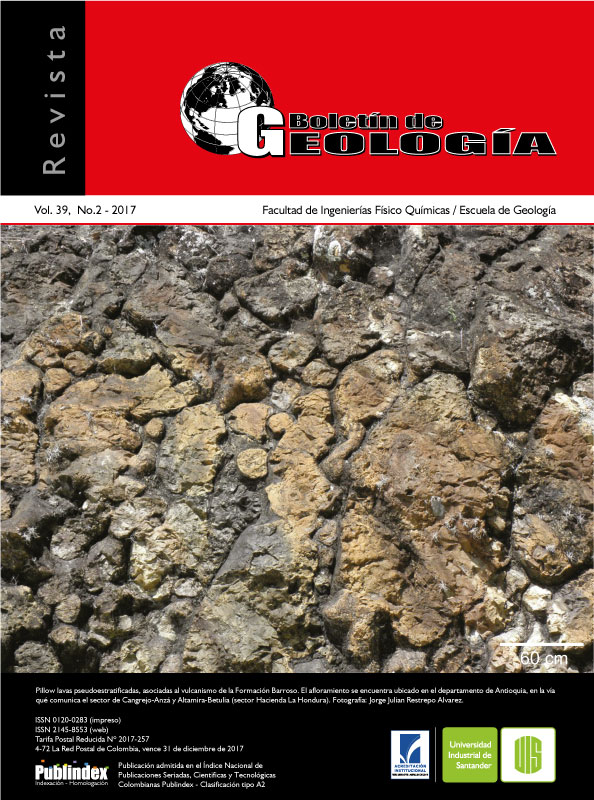METHODOLOGY TO REDUCE FAULT SHADOW: APPLIED IN A SECTOR OF THE LLANOS BASIN – COLOMBIA
Published 2017-06-14
Keywords
- fault shadow,
- false structure,
- numeric modeling,
- llanos basin,
- Casanare
How to Cite
Altmetrics
Abstract
The shadow fault distorts the image of the hanging block of normal and inverse faults, caused by strong lateral velocity changes that deviates the ray path of waves. In the Llanos basin, this effect creates in the seismic images false structures like anticlines (pull up) and synclines (push down or sag). In this paper, the factors that generate this effect and its impact on the seismic images are studied through numerical modeling. It is defined a methodology to identify the fault shadow and its causing factors, and to create the appropriate model for the pre stack depth migration – PSDM. The methodology was tested with synthetic seismograms and applied to a seismic line recorded in a sector of the Departamento de Casanare-Colombia. As a result, a reliable image in depth free of fault shadow was obtained. Even the methodology was used in a sector with normal fault it is applicable to zones with inverse faults.
Downloads
References
- Alaei, B. 2012. Seismic Modeling of Complex Geological Structures. In: Kanao, M. (Ed.). Seismic Waves - Research and Analysis. InTech, Chapter 11.
- Bain, R. 2015. Pitfalls in the seismic interpretation of fault shadow events - Vicksburg formation of south Texas. Interpretation, 3(1): SB17-SB22.
- Bayona, G., Cortés, M., Jaramillo, C., Ojeda, G., Ariztizabal J., and Reyes, A. 2008. An integrated analysis of an orogen–sedimentary basin pair: Latest Cretaceous–Cenozoic evolution of the linked Eastern Cordillera orogen and the Llanos foreland basin of Colombia. Geological Society of America Bulletin, 120(9-10): 1171-1197.
- Birdus, S. 2007. Resolving fault shadow problem by Fault Constrained Tomography. ASEG Extended Abstracts: 19th Geophysical Conference. Perth, Western Australia. pp. 1-4.
- Birdus, S., and Artyomov, A. 2010. Fault shadow distortions on 3D seismic data and their removal by depth processing. ASEG Extended Abstracts: 21st Geophysical Conference: pp. 1-4.
- Chermak, A., Veloza, G., and Ramón, J. 2009. Depth conversion in the Llanos basin: Workflow to reduce fault shadow effect. X Simposio Bolivariano Exploración Petrolera en Cuencas Subandinas, Cartagena, Colombia, pp. 12-16.
- Cooper, M., Addison, F., Alvarez, R., Coral, M., Graham, R., Hayward, A., Howe, S., Martinez, J., Naar, J., Peñas, R., Pulham, A., and Taborda, A. 1995. Basin development and tectonic history of the Llanos Basin, Eastern Cordillera, and Middle Magdalena Valley, Colombia. AAPG Bulletin, 79(10): 1421-1443.
- Fagin, S. 1996. The fault shadow problem: Its nature and elimination. The Leading Edge, 15(9): 1005-1013.
- Fagin, S. 1998 Model-based depth imaging. Society of Exploration Geophysicists. Tulsa, 184p.
- Gochioco, L., Novianti, I., and Pascual, R. 2002. Resolving fault shadow problems in Irian Jaya (Indonesia) using prestack depth migration. The Leading Edge, 21(9): 911-920.
- Martínez, N., y Agudelo, W. 2009. Efecto de las velocidades en las estructuras subyacentes a fallas - sombras de falla. X Simposio Bolivariano Exploración Petrolera en Cuencas Subandinas. Cartagena, Colombia.
- Quigley, D., Lau, A., Stewart, K., Yin, C., Mann, A., and Fitzpatrick, A. 2012. Benefits of constraints for velocity modeling a fault shadow: A case study. SEG Annual meeting. Las Vegas, pp. 1-5.
- Trinchero, E. 2000. The fault shadow problem as an interpretation pitfall. The Leading Edge, 19(2): 132-135.
